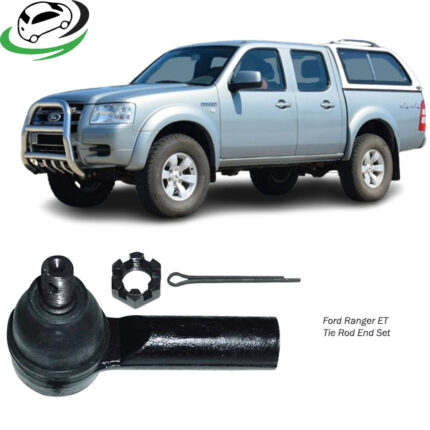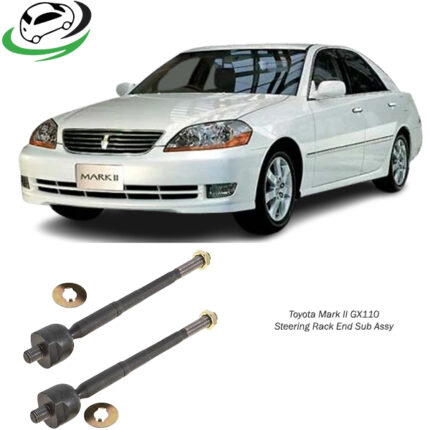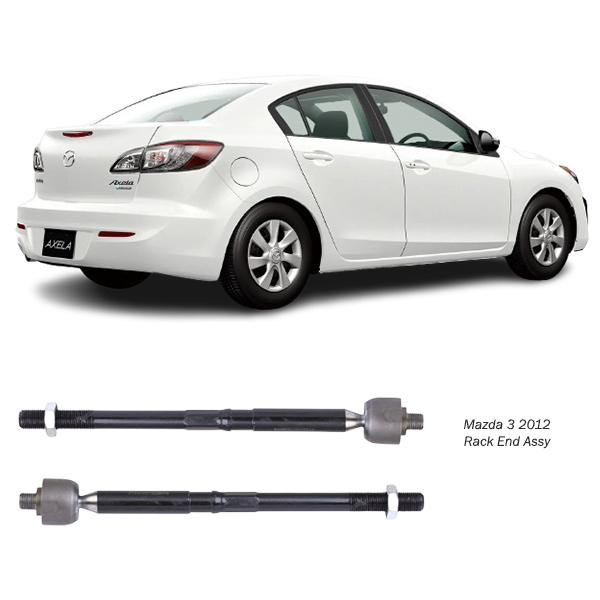-25%
Get Mazda 3 2012 Rack End Assy 3M51-3L519 in Kenya
The Rack End Assembly, often referred to simply as the rack end, is a crucial component in modern vehicle steering systems. It is an integral part of the rack-and-pinion mechanism, which is widely used in most vehicles today. This system converts the rotational motion of the steering wheel into the linear motion needed to turn the wheels. Understanding the function, design, and maintenance of the rack end assembly is vital for automotive professionals and enthusiasts alike.
Benefits;
1. Improved Steering Precision
The primary benefit of a rack end assembly is the precision it brings to steering. By connecting the steering rack to the wheel assembly, it ensures that the driver’s input is accurately transferred to the wheels. This precision is crucial for maintaining control over the vehicle, especially at high speeds or during maneuvers.
2. Enhanced Handling and Stability
A well-functioning rack end assembly contributes to the overall handling and stability of the vehicle. It ensures that the wheels respond appropriately to the steering inputs, providing a stable and predictable driving experience. This stability is particularly important in adverse driving conditions, such as wet or icy roads.
3. Reduced Wear and Tear on Tires
Proper alignment of the wheels is essential for even tire wear. The rack end assembly helps maintain this alignment by keeping the wheels correctly positioned. Misalignment can lead to uneven tire wear, reducing the lifespan of the tires and increasing maintenance costs. By ensuring proper alignment, the rack end assembly helps extend the life of the tires.
4. Enhanced Safety
Safety is a paramount concern in automotive design, and the rack end assembly plays a significant role in this regard. By ensuring precise steering control and maintaining proper wheel alignment, it helps prevent accidents caused by poor handling or tire blowouts. In emergency situations, the responsiveness of the steering system can be critical in avoiding collisions.
5. Reduced Vibration and Noise
A faulty rack end assembly can lead to increased vibration and noise in the steering system. This not only affects the comfort of the drive but can also be an indicator of more serious issues within the steering mechanism. By keeping the steering system tight and responsive, a good rack end assembly minimizes vibration and noise, contributing to a smoother and quieter ride.
6. Lower Maintenance Costs
By reducing tire wear, enhancing steering precision, and minimizing the risk of accidents, a well-maintained rack end assembly can lead to lower overall maintenance costs. Regular inspection and timely replacement of the rack end assembly can prevent more serious and costly repairs down the line.
7. Improved Fuel Efficiency
While the connection might not be immediately apparent, a properly functioning steering system can contribute to better fuel efficiency. Misaligned wheels create additional resistance, requiring more power to move the vehicle forward. By maintaining proper alignment, the rack end assembly helps reduce this resistance, leading to improved fuel economy.
8. Longevity of Steering Components
The rack end assembly is an integral part of the steering system, which includes the steering rack, tie rods, and other components. A well-maintained rack end assembly helps distribute the forces exerted during steering evenly, reducing the stress on other components. This distribution helps extend the life of the entire steering system, preventing premature wear and failure.
9. Customization and Performance Upgrades
For performance enthusiasts, the rack end assembly can be an area for customization and upgrades. High-performance or aftermarket rack end assemblies can provide even greater precision and durability, enhancing the driving experience. These upgrades can be particularly beneficial for sports cars or vehicles used in demanding driving conditions.
10. Ease of Installation and Replacement
Rack end assemblies are relatively straightforward to install and replace, especially for those with basic mechanical skills. This ease of installation means that drivers can ensure their steering system is always in optimal condition without the need for extensive downtime or complex repairs.
Design and Components
A typical rack end assembly comprises several key components:
- Inner Tie Rod: This is the central component that connects directly to the steering rack. It is usually made of high-strength steel to withstand the forces exerted during steering.
- Ball Joint: The inner tie rod features a ball joint that allows for smooth rotational movement. This joint ensures that the steering input is transmitted without binding or excessive friction.
- Protective Boot: A rubber or plastic boot covers the ball joint, protecting it from dirt, moisture, and debris. This helps to prolong the life of the ball joint and maintain smooth steering operation.
- Locking Nut: This nut secures the inner tie rod to the steering rack, ensuring a firm and stable connection.
Signs of worn out Rack End assy;
1. Unusual Tire Wear
One of the most common signs of a worn-out rack end assembly is uneven or unusual tire wear. If the inner or outer edges of the tires are wearing out faster than the rest, it could indicate that the wheels are not properly aligned due to a failing rack end assembly.
2. Loose or Unresponsive Steering
A worn rack end assembly can cause the steering to feel loose or unresponsive. You might notice excessive play in the steering wheel, where it feels like there is a delay between the movement of the steering wheel and the response of the wheels. This can make controlling the vehicle difficult and dangerous.
3. Clunking or Knocking Noises
If you hear clunking or knocking noises coming from the front of the vehicle, especially when turning or going over bumps, it could be a sign of a worn rack end assembly. These noises occur because the worn parts have excessive play, causing them to move around more than they should.
4. Vibrations in the Steering Wheel
A failing rack end assembly can cause vibrations in the steering wheel, especially when driving at higher speeds. These vibrations result from the instability in the steering system caused by the worn components.
5. Vehicle Pulling to One Side
If the vehicle tends to pull to one side while driving, it could be due to a misalignment caused by a worn rack end assembly. This pulling can make it difficult to keep the vehicle in a straight line and requires constant correction from the driver.
6. Steering Wheel Off-Center
A worn rack end assembly can cause the steering wheel to be off-center when driving straight. This misalignment can be subtle at first but can become more pronounced over time as the wear worsens.
7. Fluid Leaks
The rack end assembly is part of the larger steering system, which often includes hydraulic components. If you notice fluid leaks around the steering gear or rack, it could be a sign of a problem with the rack end assembly or associated parts. Leaking fluid can lead to a loss of power steering assist and further damage the system.
8. Difficulty Steering
Increased difficulty in steering, especially when turning the wheel, can indicate a problem with the rack end assembly. This symptom is particularly noticeable at low speeds or when parking.
9. Inconsistent Steering Response
A worn rack end assembly can cause inconsistent steering response. You might experience situations where the steering feels normal at times but becomes stiff or unresponsive at others. This inconsistency can be dangerous, especially in critical driving situations.
10. Inspection and Diagnosis
Regular inspection of the steering system can help identify issues with the rack end assembly before they become severe. Mechanics often check for excessive play in the steering components and inspect the condition of the rack end assembly during routine maintenance. If you suspect a problem, a professional inspection can confirm the diagnosis and recommend appropriate repairs.
Installation and Maintenance
Proper installation and maintenance of the rack end assembly are critical to ensure the longevity and performance of the steering system. Here are some key steps and considerations:
- Inspection: Regularly inspect the rack end assembly for signs of wear, such as loose joints, damaged boots, or unusual noises. Early detection of issues can prevent more severe problems.
- Replacement: If the rack end assembly shows significant wear or damage, it should be replaced promptly. This process typically involves removing the protective boot, disconnecting the inner tie rod from the steering rack and tie rod end, and installing the new assembly.
- Alignment: After replacing the rack end assembly, a wheel alignment is necessary to ensure proper steering geometry. Misalignment can lead to uneven tire wear and poor handling.
- Lubrication: Ensure that the ball joints are properly lubricated to reduce friction and wear. Some assemblies come pre-lubricated, while others may require periodic lubrication.
Common Issues and Troubleshooting
Several common issues can affect the rack end assembly, including:
- Wear and Tear: Over time, the ball joints and other components can wear out, leading to looseness or play in the steering.
- Damage: Physical damage from impacts or road debris can compromise the integrity of the rack end assembly.
- Boot Deterioration: The protective boot can crack or tear, allowing dirt and moisture to enter the ball joint and accelerate wear.
- Alignment Problems: Improper installation or alignment can lead to steering issues and uneven tire wear.
Follow us on Facebook for more parts.



